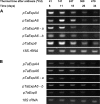Expansins expression is associated with grain size dynamics in wheat (Triticum aestivum L.)
- PMID: 20080826
- PMCID: PMC2826655
- DOI: 10.1093/jxb/erp380
Expansins expression is associated with grain size dynamics in wheat (Triticum aestivum L.)
Abstract
Grain weight is one of the most important components of cereal yield and quality. A clearer understanding of the physiological and molecular determinants of this complex trait would provide an insight into the potential benefits for plant breeding. In the present study, the dynamics of dry matter accumulation, water uptake, and grain size in parallel with the expression of expansins during grain growth in wheat were analysed. The stabilized water content of grains showed a strong association with final grain weight (r(2)=0.88, P <0.01). Grain length was found to be the trait that best correlated with final grain weight (r(2)=0.98, P <0.01) and volume (r(2)=0.94, P <0.01). The main events that defined final grain weight occurred during the first third of grain-filling when maternal tissues (the pericarp of grains) undergo considerable expansion. Eight expansin coding sequences were isolated from pericarp RNA and the temporal profiles of accumulation of these transcripts were monitored. Sequences showing high homology with TaExpA6 were notably abundant during early grain expansion and declined as maturity was reached. RNA in situ hybridization studies revealed that the transcript for TaExpA6 was principally found in the pericarp during early growth in grain development and, subsequently, in both the endosperm and pericarp. The signal in these images is likely to be the sum of the transcript levels of all three sequences with high similarity to the TaExpA6 gene. The early part of the expression profile of this putative expansin gene correlates well with the critical periods of early grain expansion, suggesting it as a possible factor in the final determination of grain size.
Figures





References
-
- Altschul SF, Gish W, Miller W, Myers EW, Lipman DJ. Basic local alignment search tool. Journal of Molecular Biology. 1990;215:403–410. - PubMed
-
- Asana RD, Williams RF. The effect of temperature stress on grain development in wheat. Australian Journal of Agricultural Research. 1965;16:1–13.
-
- Berger F, Grini PE, Schnittger A. Endosperm: an integrator of seed growth and development. Current Opinion in Plant Biology. 2006;9:664–670. - PubMed
-
- Borrás L, Slafer GA, Otegui ME. Seed dry weight response to source–sink manipulation in wheat, maize and soybean: a quantitative reappraisal. Field Crops Research. 2004;86:131–146.

